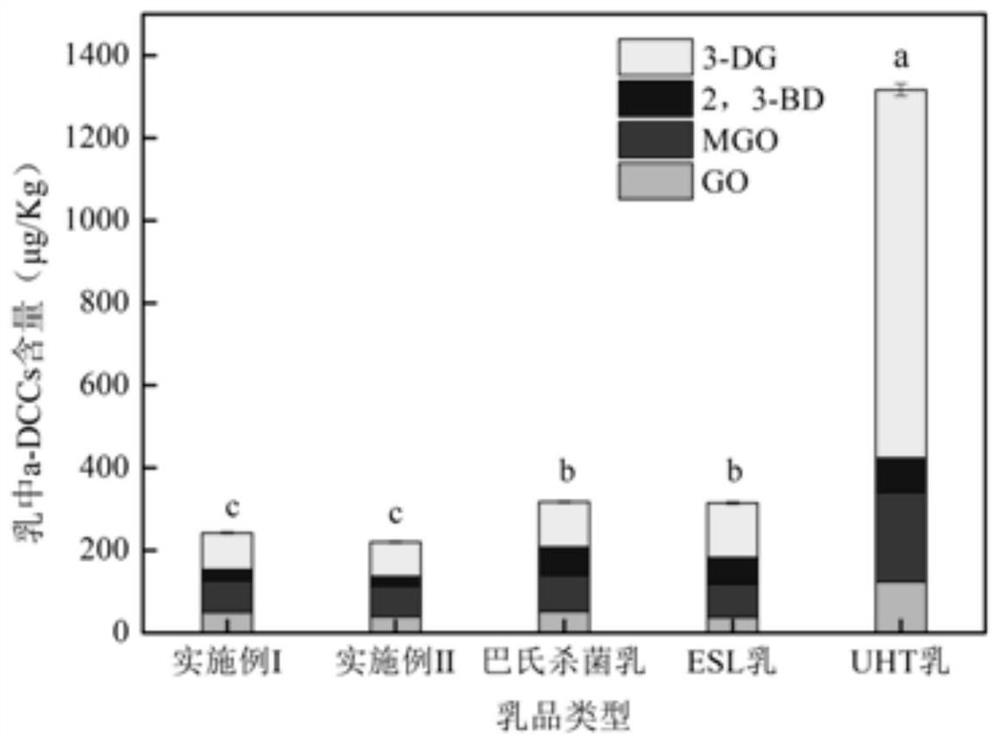Preparation method of sterilized cow milk with reduced alpha-dicarbonyl compounds
A technology of dicarbonyl compounds and milk, which is applied in the field of preparation of sterilized milk to reduce a-dicarbonyl compounds, to achieve the effect of reducing safety risks
- Summary
- Abstract
- Description
- Claims
- Application Information
AI Technical Summary
Problems solved by technology
Method used
Image
Examples
Embodiment 1
[0020] A method for preparing sterilized milk that reduces alpha-dicarbonyl compounds, comprising the steps of:
[0021] 1) Skim treatment: clean the raw milk and centrifuge it at 3500g for 18 minutes at 15°C to remove the fat in the upper layer to obtain low-fat milk with a fat content of 1.5%;
[0022] 2) Canning: filling the raw milk pretreated in step (1) in aseptic food-grade PET bottles;
[0023] 3) Ultra-high pressure sterilization: put the canned milk in step (2) in an ultra-high pressure device, working medium: water, working medium temperature: 5°C, and treat it at 520MPa for 12 minutes to reduce a-dicarbonyl Compound of sterilized milk.
Embodiment 2
[0025] A method for preparing sterilized milk that reduces alpha-dicarbonyl compounds, comprising the steps of:
[0026] 1) Skimming treatment: clean the raw milk and centrifuge at 4000g for 5 minutes at 15°C to remove the fat in the upper layer to obtain low-fat milk;
[0027] 2) Canning: filling the raw milk pretreated in step (1) in aseptic food-grade PET bottles;
[0028] 3) Ultra-high pressure sterilization: put the canned milk in step (2) in an ultra-high pressure device, working medium: water, working medium temperature: 6°C, and treat it at 500MPa for 25 minutes to reduce a-dicarbonyl Compound of sterilized milk.
Embodiment 3
[0030] A method for preparing sterilized milk that reduces alpha-dicarbonyl compounds, comprising the steps of:
[0031] 1) Skimming treatment: clean the raw milk and centrifuge at 3000g for 15 minutes at 15°C to remove the fat in the upper layer to obtain low-fat milk;
[0032] 2) Canning: filling the raw milk pretreated in step (1) in aseptic food-grade PET bottles;
[0033] 3) Ultra-high pressure sterilization: put the canned milk in step (2) in an ultra-high pressure device, working medium: water, working medium temperature: 3°C, and treat it at 600MPa for 15 minutes to reduce a-dicarbonyl Compound of sterilized milk.
[0034] Table 1 and figure 1 Compared with commercially available pasteurized milk, ESL milk and UHT milk, Example 1 and Example 2 can significantly reduce glyoxal (GO), methylglyoxal (MGO), Diacetyl (2,3-BD) and 3-deoxyglucosone (3-DG) content. Compared with UHT milk, more than 50% of a-dicarbonyl compounds produced by thermal processing can be reduced ...
PUM
 Login to View More
Login to View More Abstract
Description
Claims
Application Information
 Login to View More
Login to View More - R&D
- Intellectual Property
- Life Sciences
- Materials
- Tech Scout
- Unparalleled Data Quality
- Higher Quality Content
- 60% Fewer Hallucinations
Browse by: Latest US Patents, China's latest patents, Technical Efficacy Thesaurus, Application Domain, Technology Topic, Popular Technical Reports.
© 2025 PatSnap. All rights reserved.Legal|Privacy policy|Modern Slavery Act Transparency Statement|Sitemap|About US| Contact US: help@patsnap.com



